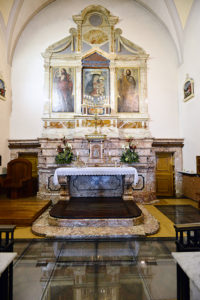
On 14 August 1808, the governing commission made up of the Mayor Giovanni Verna, Francescantonio Ventrella, the Parish Priest Nicolo Cascavilla and witnesses Michele Carrabba, Costanzo Fraticelli and Vincenzo D’Errico, drew up an inventory of the whole friary and church property. The signed inventory was consigned to Fr. Francesco Maria of Rodi, the Superior of the friary. The suppression took place on 4 July 1811.
On that day the responsible authorities for the suppression, Francescantonio Ventrella and Salvatore Cafaro summoned the community and the Superior Fr. Giovanni Maria of Monte Sant’ Angelo and proceeded with the drawing up a new inventory. The friars assisted this procedure in tears. On 8 October 1811, these friars were brusquely ordered to leave the friary within four days. On 7 February 1812, the friary was invaded by ‘a band of well armed assassins’. The mayor, to prevent this from happening again, asked the intendant to allow some of the former Capuchin friars, also priests, to act as caretakers of the friary and church. The friary was reopened in 1816 and closed again in 1866, during the Italian Masonic government. On 16 June 1886, the friary was put up for sale by the State. In 1909, the friary was reopened and in 1925, was given to the friars in perpetual lease. In 1952, the friary was enlarged. In 1959, the Our Lady of Grace Church, designed by the architect Giuseppe Gentile of Boiano was inaugurated. On 1 July 2004, the new church dedicated to St. Pio of Pietrelcina and designed by the architect Renzo Piano was inaugurated.
For information about guided tours in the places of Padre Pio you can contact the Office for Pilgrims (phone +39.0882.417500 – email info@santuariopadrepio.it)

